Common menu bar links
Breadcrumb Trail
ARCHIVED - Canadian Food Inspection Agency
 This page has been archived.
This page has been archived.
Archived Content
Information identified as archived on the Web is for reference, research or recordkeeping purposes. It has not been altered or updated after the date of archiving. Web pages that are archived on the Web are not subject to the Government of Canada Web Standards. As per the Communications Policy of the Government of Canada, you can request alternate formats on the "Contact Us" page.
Section II – Analysis of Program Activities by Strategic Outcome
This section details the CFIA’s planned activities for each of its strategic outcomes as informed by a number of factors, including Government and Agency priorities, the Agency’s corporate risk profile and the application of lessons learned. This section features a combination of the CFIA’s ongoing core program activities as well as key areas on which efforts will be focused for this reporting period.
2.1 Strategic Outcome 1: Public Health risks associated with the food supply and transmission of animal diseases to humans are minimized and managed

Mitigating risks to food safety and providing Canadian consumers with the information they need to make informed choices are areas of key focus for the CFIA.
As a contributor to the Government of Canada’s integrated approach to population health, the CFIA, in collaboration with federal, provincial and municipal governments, protects Canadians from preventable health risks related to unsafe food. Such health risks may be caused by contaminated food, improper package labelling and zoonotic diseases that could potentially be transmissible to humans. In order to mitigate the risks to achieving this strategic outcome, the Agency will concentrate its efforts in 2009–10 on the delivery of the following priorities:
- Improve inspection and surveillance approaches; and
- Modernize the Agency’s regulatory framework and tools.
2.1.1 Program Activities Summary
The Agency’s ongoing efforts toward the achievement of this strategic outcome are managed and measured within the context of the two following program activities:
- Food Safety and Nutrition Risks; and
- Zoonotic2 Risks.
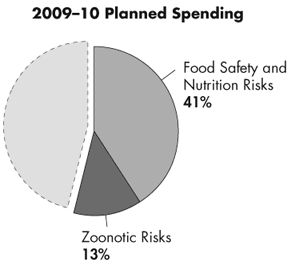
Food Safety and Nutrition Risks
With the widespread use of global supply chains to source ingredients worldwide and the evolution of new production and processing systems, risks to food safety are becoming more diverse and complex. Therefore, there are more entry points where hazards that can affect human health may be introduced along the food continuum.
The CFIA’s programming to address food safety and nutrition risk requires co-operation from federal, provincial23 and municipal partners and organizations to improve the security of food production and distribution and to identify instances where food could pose risks for the overall health of Canadians. The CFIA and co-operating jurisdictions continue efforts to improve capacity and capability to detect, track and mitigate the risks associated with diseases, pathogens, toxins, chemical contaminants and other health hazards at points along the food continuum.

In addition, within the context of the Food and Consumer Safety Action Plan, which was announced in Budget 2008, the CFIA is advancing its efforts toward active prevention to better identify food safety risks, targeted oversight to enhance inspection of high-risk food sectors, and rapid response to enhance food recall capacity and develop other tools to alert Canadians of food-related hazards.
In the summer of 2008, Canada was faced with a serious outbreak of listeria in ready-to-eat meats. During the course of this reporting period, the CFIA plans to implement important lessons learned from this outbreak including a review of policies and procedures. The CFIA is also poised to co-operate with the independent investigation into this outbreak, as announced by the Government in September 2008.
Recognizing the importance of strengthening its inspection methodology, the CFIA also plans to begin implementation of its compliance verification system (CVS) in 2009–10. The CVS is a tool to verify that industry is meeting safety standards.
The Agency’s management of human and financial resources to deliver on this program activity is measured against the performance indicators and targets presented in the following table.
| Human Resources (FTEs) and Planned Spending ($ millions) | |||||
|---|---|---|---|---|---|
| 2009-10 | 2010-11 | 2011-12 | |||
| FTEs | Planned Spending | FTEs | Planned Spending | FTEs | Planned Spending |
| 2,795 | 245.5 | 2,835 | 256.6 | 2,846 | 254.3 |
| Expected Results | Performance Indicators | Targets |
|---|---|---|
| Risks associated with food, including nutrition, are managed within acceptable limits24 | Extent to which inspected federally registered establishments comply with federal food safety requirements | ≥ 98 per cent compliance |
| Extent to which domestic and imported food products comply with federal chemical residue requirements | ≥ 95 per cent compliance | |
| Time taken to issue public warnings for Class I recalls | 100 per cent of Class I recalls are issued within 24 hours of a recall decision | |
| Extent to which nutrition information on food products inspected is accurate | ≥ 80 per cent of food products inspected declare nutrition information which is accurate | |
| Additional information: CFIA Consumer Centre: http://www.inspection.gc.ca/english/fssa/concen/concene.shtml Food Recalls and Allergy Alerts: http://www.inspection.gc.ca/english/corpaffr/recarapp/recaltoce.shtml Food and Consumer Safety Action Plan: http://www.inspection.gc.ca/english/fssa/action/actione.shtml Meat Hygiene Manual of Procedures: http://www.inspection.gc.ca/english/fssa/meavia/man/mane.shtml |
||
Zoonotic2 Risks
Animals, both domestic and wild, can potentially transmit disease-causing agents to humans. These diseases are known as “zoonoses.” BSE, AI and new strains of rabies are a few examples of diseases of animal origin that could affect public health. The CFIA focuses its work on managing and mitigating the spread of existing federally controlled zoonotic diseases and understanding, anticipating and preventing the spread of new zoonotic diseases.
The Agency works with federal, provincial and territorial partners, as well as with other national and international organizations such as the Canadian Animal Health Surveillance Network (CAHSN) and the World Organisation for Animal Health (OIE) to share scientific knowledge, establish collaborative approaches to common challenges and share best practices as they pertain to preparedness, disease mitigation and control. By way of the National Veterinary Reserve, and as part of its preparedness plan, the CFIA has put in place surge capacity for the management of animal health emergencies.
As a direct result of the CFIA’s inspections, monitoring, testing and public awareness efforts to prevent and control the spread of zoonotic diseases from animal populations to humans, Canada became recognized internationally in 2007 by the OIE as a BSE “controlled risk” country. Recognizing the importance of sound surveillance systems as a foundation for effective mitigation of zoonotic and other animal diseases, the CFIA plans to contribute to the Government of Canada’s Growing Forward initiative through efforts to enhance livestock traceability.
The Agency’s management of human and financial resources to deliver on this program activity is measured against the performance indicators and targets presented in the following table.
| Human Resources (FTEs) and Planned Spending ($ millions) | |||||
|---|---|---|---|---|---|
| 2009-10 | 2010-11 | 2011-12 | |||
| FTEs | Planned Spending | FTEs | Planned Spending | FTEs | Planned Spending |
| 679 | 75.3 | 679 | 75.1 | 679 | 74.9 |
| Expected Results | Performance Indicators | Targets |
|---|---|---|
| Risks of the transmission of federally controlled zoonotic diseases to humans are successfully managed | Number of Canadians who become infected with federally controlled zoonotic diseases by direct contact with animals or their products | No Canadians become infected with federally controlled zoonotic diseases by direct contact with animals or their products |
| Additional information: Animal diseases: http://www.inspection.gc.ca/english/anima/heasan/disemala/disemalae.shtml |
||
2.1.2 Planning Highlights
In addition to its ongoing activities, the CFIA plans to augment the achievement of the expected results for this strategic outcome by focusing efforts on the following four activities:
- Enhance the Agency’s capacity to anticipate and respond to food safety incidents to maintain the public’s confidence in Canada’s food safety regime by implementing the recommendations of expert panels such as the Academic Advisory Panel and the Food Safety Program Science Committee and by co-operating with and making appropriate adjustments as a result of the independent investigation into the listeria outbreak of summer 2008;
- Work with government partners to continue implementation of the Food and Consumer Safety Action Plan toward strengthening active prevention, rapid response and targeted oversight;
- Advance education and outreach activities that provide the public and the agri-food industry with information to make informed decisions about food safety; and
- Continue implementation of the CVS to enhance food safety oversight.
2.1.3 Benefits for Canadians
Specific benefits to Canadians include the following:
- Providing accurate and appropriate information to Canadians to make safe and nutritious food choices through the development of regulations and policies;
- Protecting Canadians from significant food hazards through the development and delivery of effective inspection, monitoring, testing and certification and timely response to food safety emergencies; and
- Protecting Canadians from preventable diseases through the development and delivery of effective inspection, monitoring and testing and timely response to zoonotic disease emergencies.
2.2 Strategic Outcome 2: A safe and sustainable plant and animal resource base
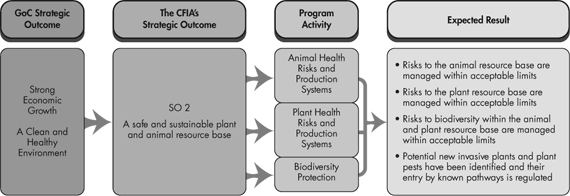
Protecting the plant and animal resource base is integral to the Canadian food supply and critical to the well-being of all Canadians. Moreover, the Government of Canada recognizes that traditional industries such as agriculture and forestry have long been anchors of our nation’s economic, environmental and social well-being. The vigour of these industries depends, in part, on the health and sustainability of the resource base on which these industries rely.
The CFIA’s programming is aimed at protecting Canada’s crops, forests, livestock and aquatic animals from regulated pests and diseases; preventing the introduction of undesirable or dangerous substances into human food or the environment through animal and plant production systems by way of animal feeds, seeds, fertilizers, supplements and veterinary biologics; and assessing the environmental sustainability and impact on biodiversity of new products derived through enabling technologies such as biotechnology.
In order to mitigate the risks to achieving this strategic outcome, the Agency will concentrate its efforts in 2009–10 on the delivery of the following priorities:
- Enhance compliance and enforcement activities; and
- Modernize the Agency’s regulatory framework.
2.2.1 Program Activities Summary
The Agency’s ongoing efforts toward the achievement of this strategic outcome are managed and measured within the context of the following three program activities:
- Animal Health Risks and Production Systems;
- Plant Health Risks and Production Systems; and
- Biodiversity Protection.
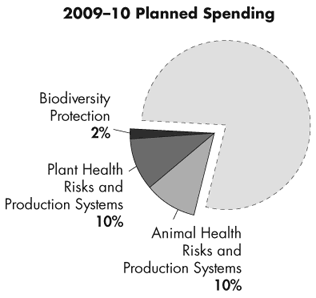
Animal Health Risks and Production Systems
The CFIA’s programming plays an important role in minimizing and managing risk by protecting Canada’s animals (including livestock, aquatic species and wildlife) from regulated diseases that are prevalent in Canada; actively managing, containing and eradicating outbreaks that occur; and supporting preparedness to mitigate the entry and spread of new diseases. The CFIA’s programs are also focused on providing oversight for production inputs, such as feed, to verify they are free of contamination that could lead to animal diseases such as BSE. Lastly, under the Health of Animals Act, the CFIA regulates animal transportation in Canada by setting reasonable standards of care that address the welfare of animals in transit.
The Agency’s plans, previously discussed in Section 2.1, for improving traceability of livestock will also contribute to the Agency’s efforts to advance on its ability to prepare for and, when needed, respond to animal health incidents. This will mitigate the risk of the entry and spread of serious animal diseases, resulting in public confidence in animal health status, animal production systems and the safety of animal products and their by-products.
Furthermore, the Agency will continue to collaborate with animal health experts, provinces, territories and other domestic and international stakeholders to better anticipate, prepare for and respond to animal health emergencies.
The Agency’s management of human and financial resources to deliver on this program activity is measured against the performance indicators and targets presented in the following table.
| Human Resources (FTEs) and Planned Spending ($ millions) | |||||
|---|---|---|---|---|---|
| 2009-10 | 2010-11 | 2011-12 | |||
| FTEs | Planned Spending | FTEs | Planned Spending | FTEs | Planned Spending |
| 652 | 56.7 | 652 | 56.6 | 652 | 56.4 |
| Expected Results | Performance Indicators | Targets |
|---|---|---|
| Risks to the animal resource base are managed within acceptable limits24 | Extent to which the CFIA’s data indicates that foreign regulated animal disease have entered Canada via specified regulated pathways | No evidence, as confirmed by the CFIA’s data, that foreign regulated animal diseases have entered into Canada through specified regulated pathways |
| Extent to which the CFIA’s data indicates the spread of foreign regulated animal diseases that entered into Canada this fiscal year11 | No evidence, as confirmed by the CFIA’s data, of spread of foreign regulated animal diseases beyond the initial control zone | |
| Extent to which renderers and feed mills inspected are without any major deviations with respect to the Feeds Regulations and the Health of Animals Regulations (Enhanced Feed Ban)12 | ≥ 95 per cent compliance rate | |
| Additional information: Animal Health Programs: http://www.inspection.gc.ca/english/anima/animae.shtml |
||
Plant Health Risks and Production Systems
Protection of the plant resource base is integral to the Canadian food supply, environment, the forestry sector and the urban forest and is critical to the well-being of the Canadian economy. The CFIA’s programming plays an important role in minimizing and managing risk by protecting Canada’s plant resource base (crops and forests) from regulated pests and disease through the regulation of plants and plant products as well as products that can pose pest pathways (e.g. soil).
Ongoing programs and initiatives aimed at mitigating risks associated with tree pests such as the brown spruce longhorn beetle and agricultural pests such as the potato cyst nematode (PCN) are developed and delivered to protect Canadian plant resources. To this end, the Agency plans to enhance surveillance toward improving its preparedness to respond to incidents such as PCN. The Agency is also poised to respond to the Auditor General’s report on plant health.
The CFIA’s programs are also focused on verifying the quality and safety of inputs, such as seeds and fertilizers, needed for plant production. The confidence held by domestic and international markets in Canadian plant products is significantly enhanced by Canada’s reputation for effectively mitigating the risk of serious pests and diseases and for administering effective product assessment programs.
The Agency’s management of human and financial resources to deliver on this program activity is measured against the performance indicators and targets presented in the following table.
| Human Resources (FTEs) and Planned Spending ($ millions) | |||||
|---|---|---|---|---|---|
| 2009-10 | 2010-11 | 2011-12 | |||
| FTEs | Planned Spending | FTEs | Planned Spending | FTEs | Planned Spending |
| 655 | 61.3 | 58025 | 49.9 | 527 | 44.0 |
| Program Activity Expected Results | Performance Indicators | Targets |
|---|---|---|
| Risks to the plant resource base are managed within acceptable limits24 | Extent to which the CFIA’s data indicates the entry and establishment of new, foreign regulated plant diseases and pests into Canada (listed diseases/pests in the regulated pest list for Canada) | No evidence, as confirmed by the CFIA’s data, of the entry and establishment of new, foreign regulated plant diseases and pests into Canada through specified regulated pathways |
| Extent of change in the presence of regulated plant diseases or pests beyond the regulated areas | No evidence of increase in the size of regulated areas for plant diseases/pests attributable to human activity | |
| Extent to which plant health risks identified by the CFIA (within andoutside Canada) are communicated to the affected stakeholders | Following the identification of a plant health risk, appropriate information is communicated with the relevantstakeholders in less than one month | |
| Additional information: Plant Protection Programs: http://www.inspection.gc.ca/english/plaveg/plavege.shtml Plant Pests: http://www.inspection.gc.ca/english/plaveg/pestrava/pestravae.shtml |
||
The Agency’s programming in support of biodiversity protection plays an important role in minimizing and managing risks to Canada’s environment. A number of acts administered by the CFIA contribute to biodiversity protection, including the Plant Protection Act and the Health of Animals Act. The CFIA’s programming includes protecting Canada’s biodiversity from the spread of IAS and other pests that could emerge due to environmental change. It also includes environmental assessment and management of novel agricultural products, including products of emerging technologies and the introduction of subsequent agricultural products.
The Agency’s management of human and financial resources to deliver on this program activity is measured against the performance indicators and targets presented in the following table.
| Human Resources (FTEs) and Planned Spending ($ millions) | |||||
|---|---|---|---|---|---|
| 2009-10 | 2010-11 | 2011-12 | |||
| FTEs | Planned Spending | FTEs | Planned Spending | FTEs | Planned Spending |
| 113 | 11.1 | 113 | 11.1 | 113 | 11.0 |
| Program Activity Expected Results | Performance Indicators | Targets |
|---|---|---|
| Risks to biodiversity within the animal and plant resource base are managed within acceptable limits24 | Extent to which authorized novel products, having undergone an environmental assessment, comply with CFIA requirements and standards outlined in the authorization | To be determined13 |
| Potential new invasive plants and plant pests have been identified and their entry by known pathways is regulated | Extent to which the CFIA’s data identifies potential new invasive plants and plant pests and demonstrates that their introduction by known pathways has been mitigated where possible | Data available to the CFIA (including from pest risk analyses, inspections, audits, surveys and other activities) indicates that the introduction of invasive plants and plant pests by regulated pathways has been mitigated |
| Additional information: Invasive Alien Species: http://www.inspection.gc.ca/english/plaveg/invenv/refe.shtml Plant Biosafety: http://www.inspection.gc.ca/english/plaveg/bio/pbobbve.shtml |
||
2.2.2 Planning Highlights
In addition to its ongoing activities, the CFIA plans to augment the achievement of the expected results for this strategic outcome by focusing efforts on the following three activities:
- Enhance the Agency’s ability to anticipate and prevent the entry of and mitigate the spread of internationally regulated animal diseases through improved traceability and targeted oversight on areas of high risk;
- Maintain the Agency’s capacity to anticipate and prevent the entry of and mitigate the spread of internationally regulated plant diseases, pests and invasive alien species; and
- Enhance efforts to support the humane treatment of animals during transport.
2.2.3 Benefits for Canadians
Specific benefits to Canadians include the following:
- Protection of the plant and animal resource bases from regulated animal diseases and regulated plant pests through effective control and surveillance;
- Reduction and prevention of economic and environmental impacts for producers and foresters resulting from destructive plant pests and diseases or the introduction of harmful innovative plant products and agricultural inputs;
- Public confidence in Canada’s ability to assess and manage the risks associated with the introduction of new species and/or new agricultural products; and
- International confidence in our regulatory systems, thereby supporting export of Canadian products.
2.3 Strategic Outcome 3: Contributes to consumer protection and market access based on the application of science and standards

The CFIA’s programming contributes to securing the conditions needed for consumer protection (as it relates to food and certain agriculture products) and for a prosperous Canadian agri-food sector that is able to access markets globally. The CFIA’s programming aims to verify that information provided to Canadian consumers through labels and advertising is truthful and not misleading. The CFIA also works to facilitate continued and new market access for the Canadian regulated sector by verifying that Canadian products meet Canadian regulations and domestic and international standards, thereby enabling these products to enter the domestic and international marketplace in the most effective and efficient manner possible.
In order to mitigate the risks to achieving this strategic outcome, the Agency will concentrate its efforts in 2009–10 on the delivery of the following priorities:
- Improve inspection and surveillance approaches; and
- Modernize the Agency’s regulatory framework and tools.
2.3.1 Program Activities Summary
The Agency’s ongoing efforts toward the achievement of this strategic outcome are managed and measured within the context of the following two program activities:
- Integrated Regulatory Frameworks;3 and
- Domestic and International Market Access.
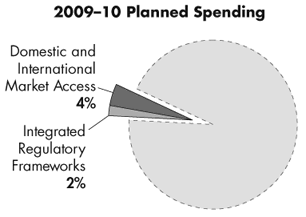
Integrated Regulatory Frameworks
The CFIA’s programming in this regard is focused on protecting consumers from unsafe or deceptive practices and verifying that Canadian agri-food products meet domestic and international standards.
Continued focus on statutes is required to keep pace with the changing environment and to protect consumers from unsafe or deceptive practices in a uniform manner. To this end, the Agency is continuing efforts toward building a regulatory base that is consistent, transparent, science-based and outcome-oriented. Agency programs and initiatives such as seed and fertilizer modernization initiatives, the Paperwork Burden Reduction Initiative, Fair Labelling Practices and the implementation of the Organic Products Regulations are all aimed at reducing barriers through the consolidation of standards and inspection techniques, thereby providing greater transparency for consumers, supporting trade and facilitating collaboration.
Canadian farmers and processors produce some of the best food in the world and the new “Product of Canada” labelling guidelines will provide Canadian families with the information they need to find those foods. Since this initiative was announced in May 2008, the Government of Canada held consultations with Canadians and stakeholders on the proposed new guidelines and their implementation. Since May 21, 2008, more than 1,500 Canadians took the time to provide their views on the proposed guidelines; over 90 per cent responded favourably. The modernized guidelines came into effect December 31, 2008. In 2009, the Agency will implement the new “Product of Canada” and “Made in Canada” guidelines to help Canadians make informed choices about the products they are purchasing.
The Agency’s management of human and financial resources to deliver on this program activity is measured against the performance indicators and targets presented in the following table.
| Human Resources (FTEs) and Planned Spending ($ millions) | |||||
|---|---|---|---|---|---|
| 2009-10 | 2010-11 | 2011-12 | |||
| FTEs | Planned Spending | FTEs | Planned Spending | FTEs | Planned Spending |
| 207 | 14.2 | 207 | 14.2 | 207 | 14.2 |
| Program Activity Expected Results | Performance Indicators | Targets |
|---|---|---|
| The CFIA’s regulatory framework provides the greatest net benefit for Canadians as it is based on scientific approaches and takes into account international contributions and stakeholders’ interests | The proportion of regulatory initiatives that are prepublished in the Canada Gazette, Part I, prior to publication in the Canada Gazette, Part II17 | ≥ 95 per cent of regulatory initiatives are prepublished in the Canada Gazette, Part I, prior to publication in the Canada Gazette, Part II |
| Extent to which the net quantity, composition, labelling and advertising of food products inspected is accurate | 70 per cent of products, labels and advertisements inspected are accurately represented18 | |
| Additional information: Organic Products: http://www.inspection.gc.ca/english/fssa/orgbio/orgbioe.shtml Paperwork Burden Reduction Initiative official site (Industry Canada): http://www.reducingpaperburden.gc.ca/epic/site/pbri-iafp.nsf/en/h_sx00001e.html Fair Labelling Practices: http://www.inspection.gc.ca/english/fssa/labeti/labetie.shtml Seeds: http://www.inspection.gc.ca/english/plaveg/seesem/seeseme.shtml Fertilizer: http://www.inspection.gc.ca/english/plaveg/fereng/ferenge.shtml |
||
Domestic and International Market Access
The CFIA contributes to securing the conditions for an innovative and prosperous economy primarily by facilitating and maintaining fair competition, supporting fair market practices, monitoring product efficacy/quality and enabling products to enter domestic and international markets.
Any misalignment of Canadian inspection systems with international demands and standards could increase the risks associated with trade related delays and diminished market access for the Canadian agri-food industry. International trade requirements, the real or perceived security of Canada’s food supply and resource base, and more stringent consumer demands require a more proactive and flexible approach in program design and delivery in order to protect consumers and enhance market access.
In 2009, the Agency plans to implement and enforce the Canada Organic Regime, which aims to develop market access and level the playing field for domestic and imported organic products while also providing assurance to consumers of the integrity of the products they are purchasing.
Internationally, the electronic certification (or e-certification) initiative takes steps to use new technology to facilitate continued market access, while reducing paperwork burden for the Canadian agri-food industry. This initiative also mitigates the risk of false or misleading representation of products and contributes to the implementation and enforcement of an effective and efficient regulatory system that is accessible, understandable and responsive to domestic and international market requirements.
The Agency’s management of human and financial resources to deliver on this program activity is measured against the performance indicators and targets presented in the following table.
| Human Resources (FTEs) and Planned Spending ($ millions) | |||||
|---|---|---|---|---|---|
| 2009-10 | 2010-11 | 2011-12 | |||
| FTEs | Planned Spending | FTEs | Planned Spending | FTEs | Planned Spending |
| 424 | 24.6 | 407 | 21.7 | 407 | 21.5 |
| Program Activity Expected Results | Performance Indicators | Targets |
|---|---|---|
| Canadian producers of food, plants, animals and related products operate within a fair and efficient marketplace, from which Canadian consumers benefit. | Extent to which certified food, animal and plant shipments meet the receiving country’s import requirements | ≥ 99 per cent meet requirements |
| Additional information: Plant Breeders Rights: http://www.inspection.gc.ca/english/plaveg/pbrpov/pbrpove.shtml Destination Inspection Services: http://www.inspection.gc.ca/english/fssa/frefra/dis/dise.shtml#serv Canada Organic Regime: http://www.inspection.gc.ca/english/fssa/orgbio/orgbioe.shtml |
||
2.3.2 Planning Highlights
In addition to its ongoing activities, the CFIA plans to augment the achievement of the expected results for this strategic outcome by focusing efforts on the following three activities:
- Continue addressing product misrepresentation issues with respect to labelling practices by implementing standards and requirements including the organic products and “Product of Canada” / ”Made in Canada” initiatives;
- Facilitate trade and maintain market access for Canadian exports by implementing e-certification and advancing the Paperwork Burden Reduction Initiative to provide technical solutions that support trade and reduce administrative burden; and
- Continue implementation of consumer protection activities, including outreach, enforcement and compliance activities.
2.3.3 Benefits for Canadians
Specific benefits to Canadians include the following:
- Access for Canadians to the nutritional information that they require to make informed decisions about the food products they purchase;
- Promotion of Canadian food, plant and animal resource base through participation in international standards-setting; and
- A strong trade position and supported market access through the consolidation of standards and inspection techniques for food, plant and animal products.
2.4 Internal Services
This program activity supports all strategic outcomes within the Agency.
2.4.1 Program Activities Summary
Internal Services are groups of related activities and resources that are administered to support the needs of programs and other corporate obligations of an organization. These groups are: Management and Oversight Services; Communications Services; Legal Services; Human Resources Management Services; Financial Management Services; Information Management Services; Information Technology Services; Real Property Services; Security Management Services; Environmental Management Services; Materiel Management Services; Procurement Services; and Travel and Other Administrative Services.
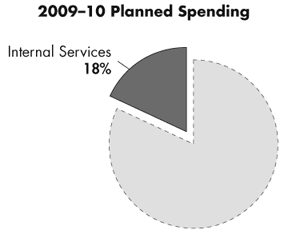
Corporate-wide services provide robust, sustainable and affordable enabling services to business lines in support of the Agency’s responsibilities and all three of its strategic outcomes.
The Agency’s management of human and financial resources to deliver on this program activity is presented in the following table.
| Human Resources (FTEs) and Planned Spending ($ millions) | |||||
|---|---|---|---|---|---|
| 2009-10 | 2010-11 | 2011-12 | |||
| FTEs | Planned Spending | FTEs | Planned Spending | FTEs | Planned Spending |
| 832 | 108.3 | 838 | 107.6 | 840 | 107.5 |
| Additional information: CFIA Renewal Plan: http://www.inspection.gc.ca/english/hrrh/renpla/renplane.shtml CFIA MAF Assessments: http://www.tbs-sct.gc.ca/maf-crg/assessments-evaluations/assessments-evaluations-eng.asp |
|||||
2.4.2 Planning Highlights
The CFIA plans to augment the achievement of the expected results for all of its strategic outcomes by focusing efforts on the following five activities:
- Implement integrated management practices that support program and investment planning, decision making and resource allocation;
- Continue prudent management of the Agency’s capital assets and stewardship of financial and non-financial resources;
- Continue implementation of the CFIA Human Resources Renewal Plan;
- Simplify internal management, policy and procedures to continue to move to a value-based regime; and
- Support business requirements with a robust, sustainable Information Management / Information Technology environment.
2.4.3 Benefits for Canadians
Specific benefits to Canadians include the following:
- Resources effectively support the delivery of the CFIA’s programs and corporate obligations; and
- Resources and personnel are used efficiently and effectively.
